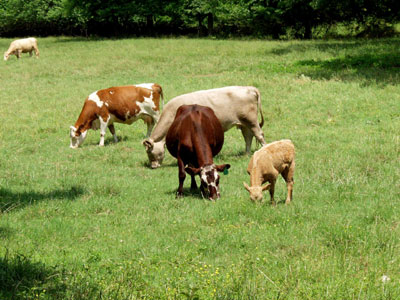|
Optimization of the quality of manufactured dairy products and dairy-based infant formula primarily depends on the casein quality of the milk base utilized. Abnormal milk (http://www.wescor.com - Mas-D-Tec) including milk that does not clot after chymosin treatment (see Author's Biography) is known to contain abundant quantities of blood enzymes which continue their hydrolytic activities in bulk milk during cold-storage, processing, and in stored manufactured products. Cheese made with milk that contains substantial amounts of non-coagulating milk exhibits a bitter taste early during aging. Stored ultra-high temperature sterilized (UHT) milk in which the base raw milk contains significant quantities of naturally hydrolyzed caseins shows age-gelation.
Cow's milk caseins hydrolyzed with pancreatic extract (trypsin) intended for infant formula manufacture produces a desirable soft curd which facilitates digestion. The non-hydrolyzed variety produces a hard-to-digest curd in the infant's stomach. This is the paradigm for the present infant milk formula originally developed in the early 1900's.
Undesirable soft curd formation in cheese-making milk after chymosin treatment, and the converse undesirable hard curd formation by unhydrolyzed cow's milk in an infant's stomach after ingestion enunciated above necessitates proper milk selection for desirable product-specific coagulation properties. It is thus of utmost importance to develop an on-farm quantifiable bioprocess parameter that estimates casein integrity in manufacturing milk procured from individual cows. Optimum on-farm/cowside selection of milk for the manufacture of targeted dairy products will eliminate the ongoing wastage of excess volumes of enzyme coagulants and lactic starter culture added to cheese vats containing poor/non coagulating milk. The bioprocess parameter could be objectively predicted at the point of milk collection from each individual cow by the application of an instrument. Cheese-making milk (hard curd) would therefore be differentiated from non/poor-coagulating milk (soft curd). Thus soft-curd milk containing naturally hydrolyzed caseins, modified lipids and signaling compounds could be separated from cheese-making milk. Health effects of bioprocessed non-cheese making milk could then be evaluated, and the bioactive compounds contained therein with potential pharmacological applications identified and further developed thereafter. Objective separation of optimum coagulating milk from naturally hydrolyzed milk at the point of collection from individual cows sets a new paradigm for dairy products manufacture.
An appraisal of the current method of infant milk formulation predicated on the new dairy products manufacturing paradigm appears congruent. Complementary addition of omega-3 fatty acids to infant milk formula, as currently practiced, for normal infant's brain development and function could be jointly investigated by co-addition of naturally hydrolyzed cow's milk caseins. The recent common occurrences of attention deficit hyperactivity disorder and autism in children may be partly related to long term accumulation of some improperly hydrolyzed casein fragments/peptides in parts of the brain and central nervous system. Long term accumulation could induce gene mutation resulting in altered protein synthesis. A simple hypothesis deserving detailed study is that all infant formula should be developed from hydrolyzed caseins as with all predigested formula. This hypothesis goes back to the origin of infant formula development - the soft curd milk theory. It is suggestive from the present observation that several generations of infant formula use possibly has resulted in genetic abnormalities which partly manifest as some sort of brain disorders.
Bioactive compounds with pharmacological potentials derivable from bioprocessed non/poor-coagulating milk would include:
 Neurotransmitting/modulating peptides and lipids Neurotransmitting/modulating peptides and lipids
 Neurostructural peptides and fatty acids Neurostructural peptides and fatty acids
 Biosignaling compounds for enhanced metabolism and fat burning Biosignaling compounds for enhanced metabolism and fat burning
 Immune system support peptides and ligands Immune system support peptides and ligands
 Appetite control peptides Appetite control peptides
 Blood vessels structural, functional and integrity modulators Blood vessels structural, functional and integrity modulators
 Bone/cartilage building and regeneration peptides-phosphate-calcium complexes Bone/cartilage building and regeneration peptides-phosphate-calcium complexes
|
|

|
